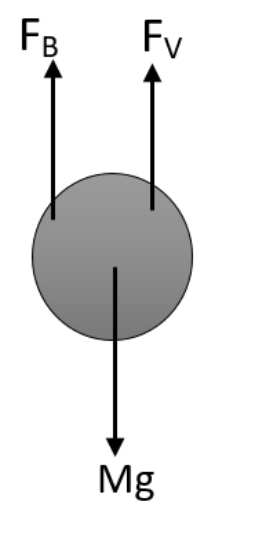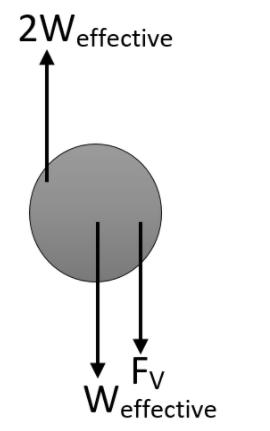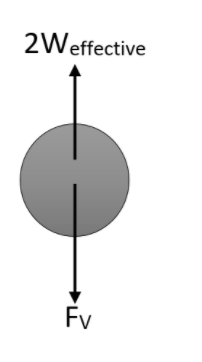
Answer
432.9k+ views
Hint: In order to find the effective weight, draw the diagram showing all the forces acting on the steel balls. Then apply the condition where the steel ball is pushed upwards with a force equal to the double of the effective weight. For this also draw a diagram showing the forces acting. These details may help you to solve this question.
Complete step-by-step answer:
First of all let us take the journey of a steel ball through the liquid mentioned in the first part of the question with a constant speed of $10cm{{s}^{-1}}$. Let is draw the diagram in which all the force acting on the steel ball is being shown.

Therefore the effective weight is given as,
${{W}_{effective}}=mg-{{F}_{B}}$

Now let us look at what happens when the force equal to the twice of the effective weight is applied in the upward direction. Let us show this also using the diagram,

The resultant of the effective weight will be,
$2{{W}_{\text{effective}}}-{{W}_{\text{effective}}}={{W}_{\text{effective}}}$

Therefore we can write that the effective weight in resultant is the same and it is acting opposite to the viscous force also. This was the same condition in the above cases also where the only difference is in the direction of motion of the steel ball. In the first case the ball was moving downwards and in second case the ball was moving upwards because of the force acting on it.
Therefore the speed of the ball will be the same in the upward direction.
$v=10m{{s}^{-1}}$
Therefore the correct answer is option C.
Note: Viscous force can be considered similar to the force of friction. Only small differences are there. Viscous force is the opposition for a body which is moving in a fluid which will prevent the motion between the two layers of a flowing fluid.
Complete step-by-step answer:
First of all let us take the journey of a steel ball through the liquid mentioned in the first part of the question with a constant speed of $10cm{{s}^{-1}}$. Let is draw the diagram in which all the force acting on the steel ball is being shown.

Therefore the effective weight is given as,
${{W}_{effective}}=mg-{{F}_{B}}$

Now let us look at what happens when the force equal to the twice of the effective weight is applied in the upward direction. Let us show this also using the diagram,

The resultant of the effective weight will be,
$2{{W}_{\text{effective}}}-{{W}_{\text{effective}}}={{W}_{\text{effective}}}$

Therefore we can write that the effective weight in resultant is the same and it is acting opposite to the viscous force also. This was the same condition in the above cases also where the only difference is in the direction of motion of the steel ball. In the first case the ball was moving downwards and in second case the ball was moving upwards because of the force acting on it.
Therefore the speed of the ball will be the same in the upward direction.
$v=10m{{s}^{-1}}$
Therefore the correct answer is option C.
Note: Viscous force can be considered similar to the force of friction. Only small differences are there. Viscous force is the opposition for a body which is moving in a fluid which will prevent the motion between the two layers of a flowing fluid.
Recently Updated Pages
How many sigma and pi bonds are present in HCequiv class 11 chemistry CBSE

Mark and label the given geoinformation on the outline class 11 social science CBSE

When people say No pun intended what does that mea class 8 english CBSE

Name the states which share their boundary with Indias class 9 social science CBSE

Give an account of the Northern Plains of India class 9 social science CBSE

Change the following sentences into negative and interrogative class 10 english CBSE

Trending doubts
Difference Between Plant Cell and Animal Cell

Differentiate between homogeneous and heterogeneous class 12 chemistry CBSE

Difference between Prokaryotic cell and Eukaryotic class 11 biology CBSE

Fill the blanks with the suitable prepositions 1 The class 9 english CBSE

Give 10 examples for herbs , shrubs , climbers , creepers

10 examples of evaporation in daily life with explanations

Write a letter to the principal requesting him to grant class 10 english CBSE

The Equation xxx + 2 is Satisfied when x is Equal to Class 10 Maths

Name 10 Living and Non living things class 9 biology CBSE



